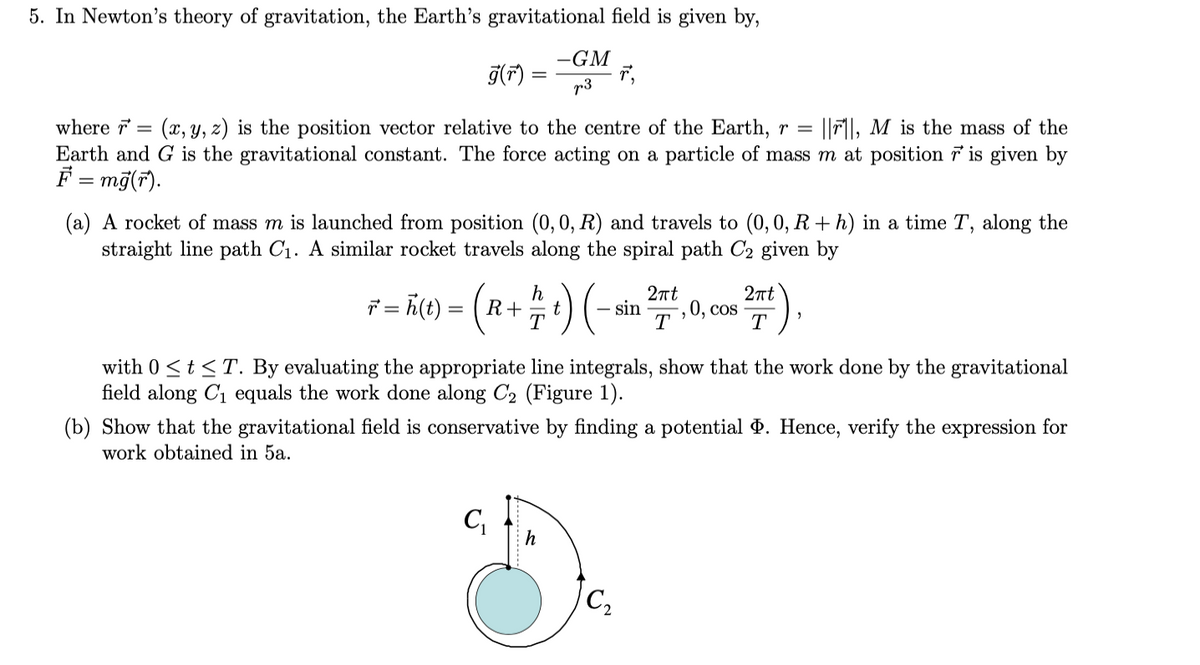In Newton's theory of gravitation, the Earth's gravitational field is given by, -GM r3 where 7 = (x, Y, z) is the position vector relative to the centre of the Earth, r = ||r||, M is the mass of the Earth and G is the gravitational constant. The force acting on a particle of mass m at position ř is given by F = mg(T). (a) A rocket of mass m is launched from position (0, 0, R) and travels to (0,0, R+ h) in a time T, along the straight line path C1. A similar rocket travels along the spiral path C2 given by h R+ 2nt = ñ(t): 2nt ,0, cos T sin with 0
In Newton's theory of gravitation, the Earth's gravitational field is given by, -GM r3 where 7 = (x, Y, z) is the position vector relative to the centre of the Earth, r = ||r||, M is the mass of the Earth and G is the gravitational constant. The force acting on a particle of mass m at position ř is given by F = mg(T). (a) A rocket of mass m is launched from position (0, 0, R) and travels to (0,0, R+ h) in a time T, along the straight line path C1. A similar rocket travels along the spiral path C2 given by h R+ 2nt = ñ(t): 2nt ,0, cos T sin with 0
Advanced Engineering Mathematics
10th Edition
ISBN:9780470458365
Author:Erwin Kreyszig
Publisher:Erwin Kreyszig
Chapter2: Second-order Linear Odes
Section: Chapter Questions
Problem 1RQ
Related questions
Question

Transcribed Image Text:5. In Newton's theory of gravitation, the Earth's gravitational field is given by,
-GM
g(F) =
p3
where 7 =
(x, y, z) is the position vector relative to the centre of the Earth, r =
|Fl, M is the mass of the
Earth and G is the gravitational constant. The force acting on a particle of mass m at position 7 is given by
F = mỹ(r).
(a) A rocket of mass m is launched from position (0, 0, R) and travels to (0, 0, R + h) in a time T, along the
straight line path C1. A similar rocket travels along the spiral path C2 given by
K() = (R+ ) (-
2nt
2nt
ř = h(t) :
- sin
-, 0, cos
T
T
with 0 <t<T. By evaluating the appropriate line integrals, show that the work done by the gravitational
field along C1 equals the work done along C2 (Figure 1).
(b) Show that the gravitational field is conservative by finding a potential d. Hence, verify the expression for
work obtained in 5a.
h
C2
Expert Solution
This question has been solved!
Explore an expertly crafted, step-by-step solution for a thorough understanding of key concepts.
Step by step
Solved in 3 steps

Recommended textbooks for you

Advanced Engineering Mathematics
Advanced Math
ISBN:
9780470458365
Author:
Erwin Kreyszig
Publisher:
Wiley, John & Sons, Incorporated

Numerical Methods for Engineers
Advanced Math
ISBN:
9780073397924
Author:
Steven C. Chapra Dr., Raymond P. Canale
Publisher:
McGraw-Hill Education

Introductory Mathematics for Engineering Applicat…
Advanced Math
ISBN:
9781118141809
Author:
Nathan Klingbeil
Publisher:
WILEY

Advanced Engineering Mathematics
Advanced Math
ISBN:
9780470458365
Author:
Erwin Kreyszig
Publisher:
Wiley, John & Sons, Incorporated

Numerical Methods for Engineers
Advanced Math
ISBN:
9780073397924
Author:
Steven C. Chapra Dr., Raymond P. Canale
Publisher:
McGraw-Hill Education

Introductory Mathematics for Engineering Applicat…
Advanced Math
ISBN:
9781118141809
Author:
Nathan Klingbeil
Publisher:
WILEY

Mathematics For Machine Technology
Advanced Math
ISBN:
9781337798310
Author:
Peterson, John.
Publisher:
Cengage Learning,

